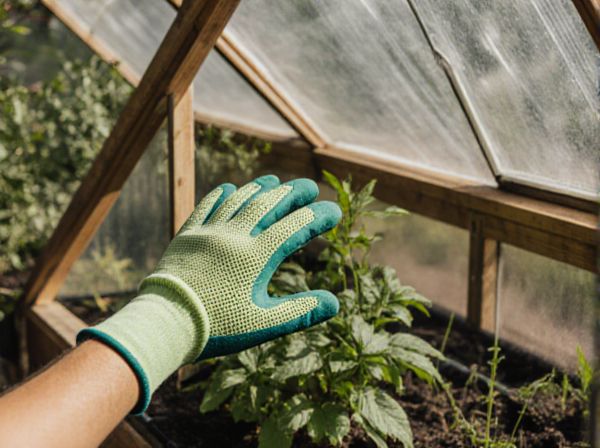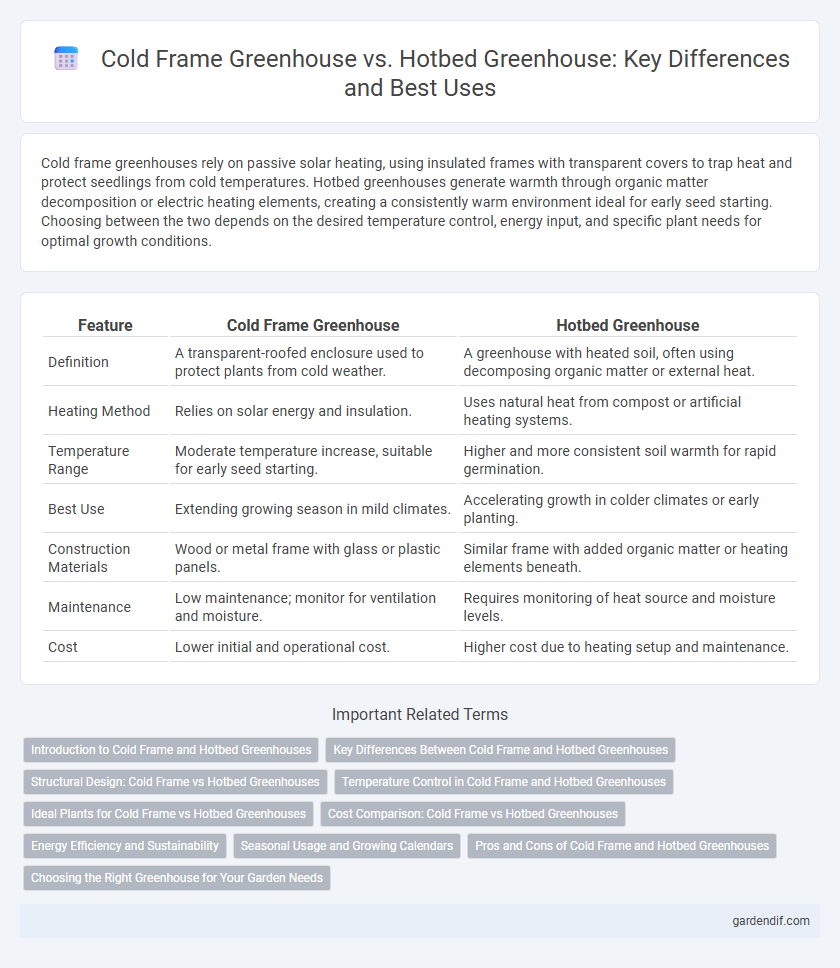
Cold Frame Greenhouse vs Hotbed Greenhouse Illustration
Cold frame greenhouses rely on passive solar heating, using insulated frames with transparent covers to trap heat and protect seedlings from cold temperatures. Hotbed greenhouses generate warmth through organic matter decomposition or electric heating elements, creating a consistently warm environment ideal for early seed starting. Choosing between the two depends on the desired temperature control, energy input, and specific plant needs for optimal growth conditions.
Table of Comparison
| Feature | Cold Frame Greenhouse | Hotbed Greenhouse |
|---|---|---|
| Definition | A transparent-roofed enclosure used to protect plants from cold weather. | A greenhouse with heated soil, often using decomposing organic matter or external heat. |
| Heating Method | Relies on solar energy and insulation. | Uses natural heat from compost or artificial heating systems. |
| Temperature Range | Moderate temperature increase, suitable for early seed starting. | Higher and more consistent soil warmth for rapid germination. |
| Best Use | Extending growing season in mild climates. | Accelerating growth in colder climates or early planting. |
| Construction Materials | Wood or metal frame with glass or plastic panels. | Similar frame with added organic matter or heating elements beneath. |
| Maintenance | Low maintenance; monitor for ventilation and moisture. | Requires monitoring of heat source and moisture levels. |
| Cost | Lower initial and operational cost. | Higher cost due to heating setup and maintenance. |
Introduction to Cold Frame and Hotbed Greenhouses
Cold frame greenhouses consist of a simple, low-profile structure with transparent panels that trap solar heat, creating a microclimate ideal for seed starting and protecting plants from frost. Hotbed greenhouses use soil heated by decomposing organic material or external heating sources to maintain higher soil temperatures, promoting faster germination and root growth in colder weather. Both structures extend the growing season by providing controlled environments, but hotbeds deliver added warmth through active heat generation.
Key Differences Between Cold Frame and Hotbed Greenhouses
Cold frame greenhouses rely on passive solar heating and natural insulation to protect plants from frost, while hotbed greenhouses use an active heat source, often decomposing organic material, to maintain soil warmth. Cold frames are typically smaller, simpler structures ideal for extending the growing season, whereas hotbeds require more maintenance but enable earlier planting by providing consistent heat. The choice between cold frames and hotbeds depends on the desired temperature control, crop type, and gardening goals.
Structural Design: Cold Frame vs Hotbed Greenhouses
Cold frame greenhouses feature a simple, box-like structure with transparent lids designed to capture solar heat and protect seedlings from cold weather. Hotbed greenhouses incorporate an added heat source, such as decomposing organic material or heating cables, within their foundation to maintain warmer soil temperatures. The structural design difference lies in the integration of this heat element in hotbeds, enabling earlier planting and faster growth compared to passive cold frames.
Temperature Control in Cold Frame and Hotbed Greenhouses
Cold frame greenhouses maintain moderate temperatures by using solar heat retention and insulation, providing a controlled environment ideal for hardening off seedlings without overheating. Hotbed greenhouses incorporate an active heat source, such as decomposing organic matter or electric heating, to elevate soil and air temperatures, enabling earlier planting and extended growing seasons. Temperature control in hotbed greenhouses is more precise and effective for frost protection compared to passive cold frames, making them suitable for more temperature-sensitive crops.
Ideal Plants for Cold Frame vs Hotbed Greenhouses
Cold frame greenhouses are ideal for growing hardy plants such as lettuce, spinach, and kale, which require moderate warmth and protection from frost. Hotbed greenhouses create a warmer environment perfect for heat-loving plants like tomatoes, peppers, and melons, benefiting from the soil heating generated by compost or manure beneath the bed. Selecting the right greenhouse type depends on the temperature needs and growth stages of specific crops to optimize yield and plant health.
Cost Comparison: Cold Frame vs Hotbed Greenhouses
Cold frame greenhouses generally have lower initial costs due to simpler construction materials like wood and glass or plastic panels, making them ideal for budget-conscious gardeners. Hotbed greenhouses require additional expenses for heating elements such as electric cables or manure compost layers to maintain higher soil temperatures, increasing overall investment. Long-term energy costs for hotbed greenhouses can be higher, whereas cold frames rely primarily on solar heat, resulting in minimal operating expenses.
Energy Efficiency and Sustainability
Cold frame greenhouses utilize natural solar energy and soil heat, minimizing the need for external energy sources and enhancing sustainability through passive temperature regulation. Hotbed greenhouses generate warmth via decomposing organic matter or heating cables, increasing energy consumption but extending growing seasons for certain crops. Cold frames generally offer higher energy efficiency, while hotbeds provide targeted heat control at the cost of greater resource usage.
Seasonal Usage and Growing Calendars
Cold frame greenhouses are designed for extending the growing season by protecting plants during early spring and late fall, making them ideal for seed starting and hardening off seedlings. Hotbed greenhouses generate heat through decomposing organic matter or external sources, enabling year-round cultivation even in winter by maintaining warmer soil temperatures. Farmers and gardeners use cold frames primarily for transitional seasonal growth, while hotbeds support continuous planting schedules regardless of outdoor climate fluctuations.
Pros and Cons of Cold Frame and Hotbed Greenhouses
Cold frame greenhouses provide energy-efficient seed starting by trapping solar heat, making them ideal for extending growing seasons with minimal cost, but they lack active heating, limiting temperature control during colder months. Hotbed greenhouses incorporate heat sources like compost or electrical heating, ensuring consistent warmth for faster plant growth and frost protection, though they require higher energy input and more maintenance. Both structures support plant propagation, but cold frames suit mild climates and beginners, whereas hotbeds benefit gardeners needing year-round warmth and greater temperature regulation.
Choosing the Right Greenhouse for Your Garden Needs
Cold frame greenhouses offer a passive heat solution using solar energy and insulation, suitable for protecting seedlings and extending the growing season without additional energy costs. Hotbed greenhouses use active heat sources like compost or electric heating to provide consistent warmth, ideal for early seed starting and growing heat-loving plants in colder climates. Selecting the right greenhouse depends on your climate, plant types, and energy availability, with cold frames being cost-effective and hotbeds offering greater temperature control.
Cold Frame Greenhouse vs Hotbed Greenhouse Infographic

 gardendif.com
gardendif.com